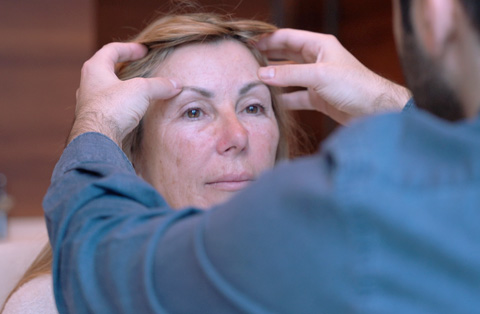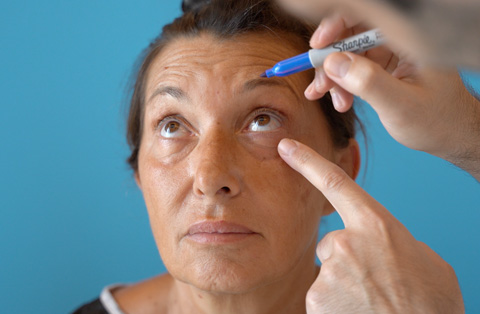Wondering how to reduce swelling and bruising after a facelift? Swelling is a natural part of the healing process, but managing it effectively can speed up recovery and help you see results sooner. From the moment your surgery is complete, the healing timeline begins, and understanding what to expect can make the process smoother.
In this article, we’ll break down the facelift swelling timeline and share expert tips to minimize discomfort and bruising. Whether you're preparing for surgery or already in recovery, discover how to take care of your skin, reduce swelling, and achieve the best possible results.
What is the typical facelift swelling timeline?
Swelling is a common and expected part of facelift recovery. It typically follows a predictable pattern, but the intensity and duration can vary depending on the individual and the extent of the procedure. Here’s a general timeline of what you can expect during the healing process:
Day 1-3 (Immediate Post-Surgery): Swelling will be at its peak during the first 48-72 hours after surgery. Bruising may also appear, and the face can feel tight or tender. It's essential to rest and keep your head elevated to minimize swelling.
Day 4-7 (First Week): By the end of the first week, the swelling and bruising should begin to subside, though the face may still appear puffy. You may start feeling more comfortable moving around, but it's important to avoid strenuous activities.
Week 2 (Early Recovery): Swelling continues to decrease, and most of the initial bruising will fade. You’ll notice a more defined contour in your face, though some areas may still feel numb or stiff.
Week 3-4 (Visible Improvement): By the third and fourth weeks, swelling should be significantly reduced, and most patients can return to normal daily activities. Some mild swelling may persist, especially in the lower face and neck, but overall results will be more noticeable.
Month 2-3 (Final Stages of Healing): By this point, most swelling will be gone, and the final shape of your face will begin to take form. Any residual swelling is usually minimal and typically only noticeable to the patient.
Month 6-12 (Final Results): It may take up to a year for all swelling to fully resolve and for the final results of your facelift to be visible. However, most patients feel fully recovered and see dramatic improvements by the 3-month mark.
Every patient heals at a different pace, but following your surgeon’s post-operative care instructions can help reduce swelling and ensure a smooth recovery.
How long does swelling last after a facelift?
Swelling after a facelift can last for several weeks, though it decreases significantly over time. In general:
The most intense swelling occurs within the first 2-3 days after surgery.
By the end of the first week, swelling begins to subside, but noticeable puffiness may still be present.
Most swelling resolves within 3-4 weeks, with the majority of patients seeing a significant reduction during this time.
Mild residual swelling may persist for up to 2-3 months, particularly in areas like the neck or jawline.
Complete resolution of swelling can take up to 6-12 months, though the final results of the facelift are usually visible much earlier, often around the 3-month mark.
Each person's recovery timeline varies, but following post-surgical care instructions can help reduce swelling faster.
What to expect in the first month after facelift surgery?
In the first month after facelift surgery, you can expect a gradual reduction in swelling and bruising, with visible improvements in your facial contours becoming more noticeable over time. Here's a brief overview:
Week 1: Swelling and bruising will peak in the first few days, then begin to subside. You’ll need to rest, keep your head elevated, and avoid strenuous activities.
Week 2: Swelling continues to decrease, and bruising fades. You may feel comfortable resuming light activities, though some tightness or numbness might persist.
Weeks 3-4: Swelling is significantly reduced, and you’ll see more defined facial contours. Most patients can return to their regular routines, though minor swelling and tightness may still be present.
By the end of the first month, you should be looking and feeling much better, though full healing will continue over the next few months.
When will I see the final results of my facelift?
You can expect to see the final results of your facelift within 3 to 6 months after surgery. Here’s a general timeline:
3 months: By this point, most of the swelling will have subsided, and you’ll have a clearer view of your rejuvenated facial contours. However, some minor swelling may still linger.
6 months to 1 year: Full healing and resolution of all swelling occur during this period. At this stage, you will see the final, long-lasting results of your facelift, with a smoother, more youthful appearance.
Patience is key, as the healing process varies from person to person, but most significant improvements are noticeable by the 3-month mark.
How can I reduce swelling after facelift surgery?
Swelling is a natural part of the healing process after a facelift, but it can be uncomfortable and affect how quickly you see your results. Fortunately, there are several effective ways to reduce swelling and promote faster recovery.
By following the right post-surgery care practices, you can minimize discomfort and help your face heal smoothly. In this section, we’ll cover expert tips to reduce swelling, including practical methods that can make a big difference in your recovery.
Effective ways to minimize swelling and bruising
Reducing swelling and bruising starts with taking care of yourself immediately after surgery. Here are some effective methods to promote faster healing:
Stay Hydrated: Drink plenty of water to flush out toxins and reduce fluid retention.
Avoid Salt: Consuming salty foods can increase swelling, so stick to a low-sodium diet during recovery.
Follow Your Surgeon’s Instructions: Take prescribed medications as directed and avoid anti-inflammatory medications like aspirin, which can worsen bruising.
Rest: Avoid physical exertion for the first few weeks, as strenuous activities can increase swelling.
These steps, combined with proper post-surgery care, can speed up the healing process and minimize swelling.
The importance of keeping your head elevated
Keeping your head elevated is one of the most effective ways to reduce swelling after a facelift. Elevation helps prevent fluid from accumulating in your face, reducing both swelling and bruising. For the first few days after surgery, it’s recommended to sleep with your head elevated at a 30-45 degree angle using pillows or a wedge.
This position also encourages proper blood circulation and reduces pressure on healing tissues. Maintaining elevation, even during the day when resting, can significantly improve the speed and comfort of your recovery.
Using cold compresses to reduce facial swelling
Cold compresses are another useful tool in managing post-surgery swelling. Applying cold compresses to your face during the first 48 hours after surgery can help constrict blood vessels, reduce swelling, and soothe discomfort.
To use, gently place a cold pack or soft ice pack wrapped in a cloth on the swollen areas for 10-15 minutes at a time. Be sure to avoid applying ice directly to the skin, as this can cause damage. Always follow your surgeon's guidance on how often to use cold compresses to ensure optimal results without overdoing it.
What are the best practices for managing bruising during recovery after facelift?
Bruising is a common part of the recovery process after a facelift. While it’s temporary, it can be concerning for patients eager to see their results. Fortunately, there are several ways to minimize bruising and promote faster healing.
Managing bruising properly not only improves your comfort but also helps you achieve better post-surgery results.
Tips for reducing bruising around incision sites
To minimize bruising around the incision sites, follow these practical tips:
Apply Cold Compresses: In the first 48 hours, using cold compresses helps reduce bruising by constricting blood vessels. Apply them gently for 10-15 minutes at a time.
Elevate Your Head: Keeping your head elevated while sleeping and resting reduces blood flow to the face, helping to minimize both bruising and swelling.
Avoid Certain Medications: Avoid blood-thinning medications like aspirin, ibuprofen, or herbal supplements before and after surgery unless approved by your surgeon. These can worsen bruising.
Eat a Healthy Diet: Nutrient-rich foods, especially those high in vitamin C and K, can aid in the healing process and reduce bruising.
Be Gentle with Your Skin: Avoid rubbing or applying pressure to the incision sites. Wearing loose clothing with easy-to-open tops can prevent accidental pulling on the skin.
By following these steps, you can reduce the severity and duration of bruising after your facelift.
How long does bruising typically last?
Bruising typically lasts for 1 to 2 weeks after a facelift. Here's a general timeline:
First Week: Bruising is most visible during the first 5-7 days, especially around the incision sites and areas that were tightened during surgery. This is the time when the body is healing most actively.
Week 2: Bruising should begin to fade, turning from dark purple or blue to yellow or light brown as it heals.
Weeks 3-4: By the third week, most bruising will have resolved. While some mild discoloration may persist, it is usually minimal and can be easily covered with makeup.
Keep in mind that the timeline may vary depending on the individual and the extent of the surgery.
When to contact your plastic surgeon about bruising concerns?
While bruising is normal, there are certain signs that could indicate a complication. Contact your plastic surgeon if you experience:
Excessive or spreading bruising that doesn’t improve or worsens after the first few days.
Severe pain in bruised areas that is not managed by prescribed medications.
Signs of infection, such as increased redness, warmth, or pus near the incision sites.
If you’re unsure whether your bruising is normal or cause for concern, don’t hesitate to reach out to your surgeon. They can assess your symptoms and provide reassurance or additional care if necessary.
Are there any specific post-operative instructions to follow for optimal recovery?
Proper post-operative care is crucial to ensure a smooth recovery and achieve the best results after facelift surgery. Following your surgeon’s instructions can reduce complications, minimize discomfort, and help you heal faster.
Whether it's managing swelling, caring for incisions, or staying hydrated, these practices will guide you through a successful recovery.
Key tips for managing swelling in the weeks following surgery
Swelling is expected after a facelift, but managing it properly can speed up your recovery:
Keep Your Head Elevated: Always sleep with your head elevated for the first few weeks to prevent fluid buildup and reduce swelling.
Cold Compresses: Apply cold compresses during the first 48 hours to minimize swelling and discomfort, but avoid applying them directly to the skin.
Avoid Strenuous Activities: Refrain from exercise or heavy lifting for at least two weeks, as physical exertion can increase swelling.
Limit Salt Intake: Reducing your sodium intake helps prevent fluid retention, which can worsen swelling.
These strategies will help you manage post-surgical swelling and support a faster healing process.
How to care for incision sites to promote healing
Caring for your incision sites properly is essential for preventing infection and ensuring smooth, scar-free healing:
Keep the Area Clean: Follow your surgeon’s instructions on how to clean the incision sites. This usually involves gentle cleansing with a mild solution to keep the area free of bacteria.
Avoid Touching the Incisions: Refrain from touching or rubbing the incisions, as this can introduce bacteria and delay healing.
Apply Recommended Ointments: Use any prescribed or recommended ointments to keep the area moisturized and promote healing.
Protect from Sun Exposure: UV rays can darken scars, so avoid direct sun exposure and wear sunscreen on your face after your surgeon clears you to do so.
Following these guidelines helps your skin heal cleanly, reducing the risk of visible scars.
Related Articles:
The role of hydration in the recovery process
Staying well-hydrated is critical to your body’s healing process:
Flushes Out Toxins: Drinking plenty of water helps your body flush out toxins and reduces inflammation, which can support quicker recovery.
Supports Skin Health: Hydrated skin is more elastic and heals faster, which is important for optimal incision healing and reducing swelling.
Aids in Recovery: Proper hydration helps maintain your energy levels and assists in the body’s natural repair processes.
Make sure to drink at least 8-10 glasses of water per day to keep your body hydrated and promote efficient healing. Avoid alcohol and caffeinated drinks, which can dehydrate you.
By following these post-operative instructions, you’ll not only speed up your recovery but also improve the long-term results of your facelift.
What factors can affect the duration of swelling after a facelift?
Swelling is a normal part of facelift recovery, but the duration and severity can vary from person to person. Several factors play a role in how long the swelling lasts, including the type of facelift performed, the patient's age and health, and how closely post-operative care instructions are followed.
Impact of different facelift techniques on swelling (e.g., deep plane facelift)
The type of facelift performed can significantly influence the amount and duration of swelling:
Traditional Facelift: This involves more extensive tissue manipulation, often resulting in longer-lasting swelling due to the larger areas being treated.
Deep Plane Facelift: While it provides natural, long-lasting results, the deep plane facelift typically involves more swelling in the first few weeks because it targets deeper layers of facial tissue.
Mini Facelift: A less invasive option, the mini facelift usually results in less swelling and a faster recovery due to smaller incisions and less tissue manipulation.
The more invasive the technique, the more swelling you can expect, although the timeline can vary based on individual healing responses.
How age and overall health influence recovery time?
Your age and general health can also impact how long swelling lasts:
Age: Younger patients typically have better skin elasticity and circulation, allowing for faster recovery and reduced swelling. Older patients may experience longer-lasting swelling due to decreased skin elasticity and slower healing processes.
Overall Health: Patients in good health tend to recover faster. Factors such as smoking, poor diet, and pre-existing conditions can slow down the healing process, prolong swelling, and increase the risk of complications.
A healthy lifestyle and good physical condition before surgery can lead to a quicker reduction in swelling.
The effect of following post-operative instructions on swelling reduction
Closely following your surgeon’s post-operative care instructions can significantly reduce swelling and speed up recovery:
Head Elevation: Keeping your head elevated while resting or sleeping helps drain excess fluids and reduce swelling.
Cold Compresses: Proper use of cold compresses in the first 48 hours can minimize initial swelling.
Avoiding Strenuous Activities: Overexertion can increase blood flow to the face and worsen swelling, so it’s important to avoid exercise and heavy lifting for several weeks.
Medication and Diet: Taking prescribed medications and maintaining a low-sodium diet can help control inflammation and fluid retention.
By adhering to these instructions, patients can reduce the duration and severity of swelling, leading to a smoother recovery.
When should I be concerned about swelling or bruising after my facelift?
Swelling and bruising are natural parts of the facelift recovery process, but it's important to know when these symptoms are within the normal range and when they might signal a problem.
While some discomfort is expected, being able to recognize signs of abnormal swelling or bruising can help prevent complications and ensure a smooth recovery.
Signs of normal vs. abnormal swelling and bruising
Normal swelling and bruising typically follow a predictable pattern:
Normal Swelling: Most noticeable in the first 3 days, swelling gradually subsides over the next 2-3 weeks. Mild puffiness may persist for a few months, especially in the lower face or neck.
Normal Bruising: Bruising usually peaks in the first week and fades over 2-3 weeks, changing from dark purple or blue to yellowish as it heals.
Abnormal swelling and bruising, however, may indicate complications:
Abnormal Swelling: Rapid increase in swelling after the initial post-operative period, swelling that worsens instead of improving, or one side of the face being significantly more swollen than the other.
Abnormal Bruising: Extensive bruising that spreads beyond the surgical area or bruising that becomes darker and more painful over time instead of fading.
If swelling or bruising seems excessive or persists longer than expected, it may be a sign of an issue that needs attention.
When to seek medical attention for post-operative complications?
You should contact your surgeon if you experience any of the following symptoms:
Severe Pain: Uncontrolled pain or a sudden increase in discomfort may indicate a hematoma (a collection of blood) or infection.
Redness and Warmth: Red, warm, or tender areas around the incision sites may suggest infection.
Fever: A high fever could be a sign of infection and requires prompt medical attention.
Uneven or Asymmetrical Swelling: Significant swelling on one side of the face or persistent asymmetry may indicate a problem with the healing process.
If you notice any of these symptoms, it's important to seek medical advice immediately. Early intervention can prevent complications and help ensure a successful recovery.
How can I prepare for the recovery process before my facelift surgery?
Preparing for your facelift recovery in advance can make the healing process smoother and more comfortable. By gathering the right supplies, making important lifestyle changes, and setting realistic expectations, you’ll ensure that your recovery is as stress-free as possible. Taking the time to prepare will not only help manage post-surgical symptoms like swelling and bruising but also improve your overall outcome.
Essential items to have on hand for managing swelling and bruising
Having the right items ready can make a big difference in managing swelling and bruising during recovery. Some essential items include:
Cold Compresses or Ice Packs: These help reduce swelling and discomfort during the first few days after surgery. Use soft, flexible cold packs that conform to your face for maximum comfort.
Pillows or Wedge for Elevation: Keeping your head elevated is crucial for reducing swelling. Extra pillows or a wedge pillow will help you sleep at a 30-45 degree angle.
Loose, Button-Up Clothing: Avoid clothing that requires pulling over your head to prevent accidental contact with the face. Choose loose, easy-to-wear tops with front buttons or zippers.
Gentle Cleansers and Ointments: Your surgeon may recommend specific products to clean your incision sites and keep them moisturized to promote healing.
Arnica and Bromelain Supplements: These natural supplements are often suggested to help reduce bruising and swelling, though you should always consult your surgeon before use.
Having these essentials ready before surgery ensures you’re prepared to manage common symptoms and recover more comfortably.
Lifestyle adjustments to make before surgery for optimal healing
Making certain lifestyle adjustments before your facelift can promote faster healing and reduce the risk of complications:
Stop Smoking: Smoking impairs circulation and delays wound healing, so it’s essential to quit smoking at least 4-6 weeks before surgery.
Avoid Blood-Thinning Medications: Discontinue the use of aspirin, ibuprofen, and other blood-thinning medications or supplements as instructed by your surgeon to reduce the risk of excessive bruising.
Adopt a Healthy Diet: A diet rich in vitamins, antioxidants, and protein supports tissue repair and boosts your immune system. Focus on whole foods like leafy greens, fruits, lean proteins, and nuts.
Stay Hydrated: Begin increasing your water intake before surgery to keep your body well-hydrated and prepare for the healing process.
Exercise Moderately: Light to moderate exercise before surgery can improve circulation and overall health, which can aid in a smoother recovery.
By making these adjustments, you’ll set the foundation for faster healing and better results.
Setting realistic expectations for your facial plastic surgery recovery
Understanding what to expect during recovery is important to avoid frustration and anxiety. Set realistic expectations by considering the following:
Recovery Takes Time: While initial swelling and bruising subside within a few weeks, complete recovery and the final results of your facelift can take 3-6 months. Be patient with your body as it heals.
There Will Be Discomfort: You may experience tightness, swelling, bruising, and mild pain, especially in the first week. These are all normal parts of the healing process.
You Won’t See Immediate Results: Swelling and bruising will obscure your final appearance for the first few weeks, so don’t worry if you don’t see the full impact of your facelift right away.
Follow-Up Appointments Are Crucial: Attending your follow-up appointments ensures your surgeon can monitor your healing progress and address any concerns.
By setting realistic expectations, you can approach your recovery with confidence and patience, ensuring the best outcome from your facelift.






